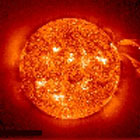 |
|||||||
|
|||||||
|
Hypothesis upon hypothesisBy Dr Philip Dawson Dr Ian Flanigan's article, "The core of climate science is in the real-world data" (News Weekly, November 17), rightly mentions data to prove hypotheses, and convincingly shows two graphs to disprove the carbon dioxide raises global temperature hypothesis. There are a couple of problems with this. First, neither graph shows real-world data: each shows interpretations of the data based on numerous assumptions (hypotheses). Deriving historic temperature estimates from ice cores requires many assumptions. First, how do you date the ice cores? The assumption that so many layers of ice equals so many years requires a leap of faith. It is a reasonable assumption that each layer equals one storm, but how many storms in a year? Various ancient volcanic eruptions produce ash with layers of ash in the ice of similar composition, which may be OK as far back as 1400 BC, where we have well documented datings of the said eruptions, but extrapolating to "deep time" involves way too many assumptions. Tree ring dating is well known, but to use it one must know that not every tree produces one growth ring per year, some produce two, three or four, some vary and some in semi-arid regions produce one each time it rains! Assuming the level of carbon dioxide in a bubble trapped in ice equals the average level of carbon dioxide in the atmosphere a long time ago assumes no gas leaked in or out ‚Äď a dubious assumption. Even solid ice allows some gas in and out, as does rock. As for estimating temperature aeons ago from an ice core, how many assumptions in that? I have done some statistics. A rule of thumb is anything that involves three assumptions in a row is not a hypothesis worth entertaining. So, that is where the argument rests. Meanwhile, real-world actual temperature recordings exist back as far as 1750 in the United States (New York City and upstate) and to the mid 17th century in England; and the Royal Navy has taken ocean surface and water temperature measurements since then too. I have not read of the Navy collating and releasing these measurements. It would be interesting to see these data, but also to know why they have not released them. I understand temperatures in New York have gone up by 5 degrees Celsius since 1750, but have not risen in upstate New York. A powerful demonstration of the heat-island effect. Another point worth considering is that models suggest carbon dioxide rises on their own only increase temperature via greenhouse effect a small amount, and there is a ceiling to this effect, as there is with all chemical reactions where increasing beyond a certain level has no further effect. The climate catastrophists argue there is a "forcing effect" due to interactions of carbon dioxide, but their models suggest certain effect on the middle atmosphere which have not been borne out by observations, as Bob Carter and Ian Plimer have convincingly demonstrated in their books. |
|
|



